This article is a translation of the following Japanese article into English. Some expressions may not be accurate.
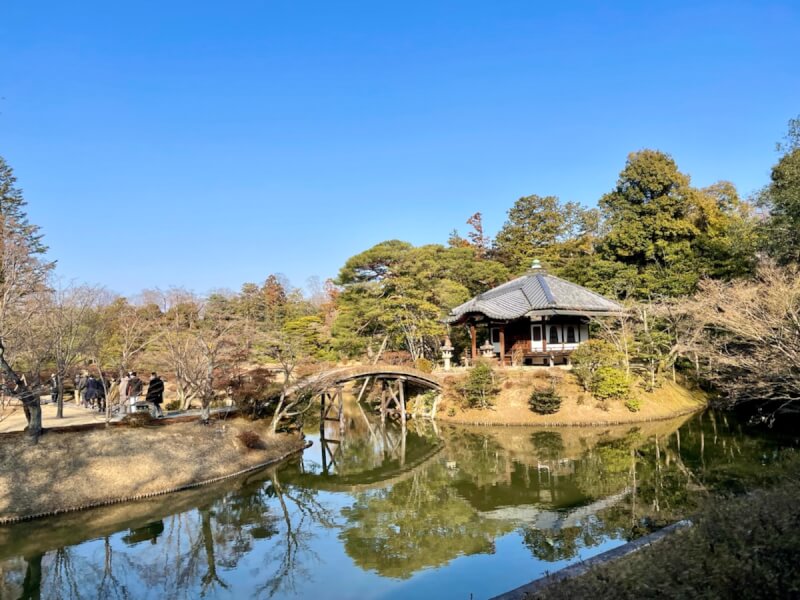
Advance Reservations Required
Check the Imperial Household Agency website every day. And never give up until the end.
Katsura Imperial Villa(Katsura Rikyu) is only open to people who have made reservations in advance OR who are able to accept reservations on the day of the event. Reservations are not made on a first-come, first-served basis, but are drawn each night.
Katsura Imperial Villa is called Katsura Rikyu in Japanese, and will be described as such in this article. Rikyu means a palace established outside of the Imperial Palace or Royal Palace.
So even if the website shows 2 openings, if 5 people apply on the same day, you will be selected by lottery. However, if there are cancellations, there will be openings, so if you check the website every day, you may be able to apply and be lucky enough to get in.
So it is important to never give up until the last minute. I finally won 4 days before my trip..!
We are heading to the long-awaited Katsura Rikyu!
From Kyoto Station to Katsura Rikyu
Saryo FUKUCHA Kyoto station Store
Katsura Rikyu is located a bit out of the way, so we took a bus from Kyoto Station. No matter how many times I see Kyoto Station, it is still amazing, and I can’t help taking pictures of it.
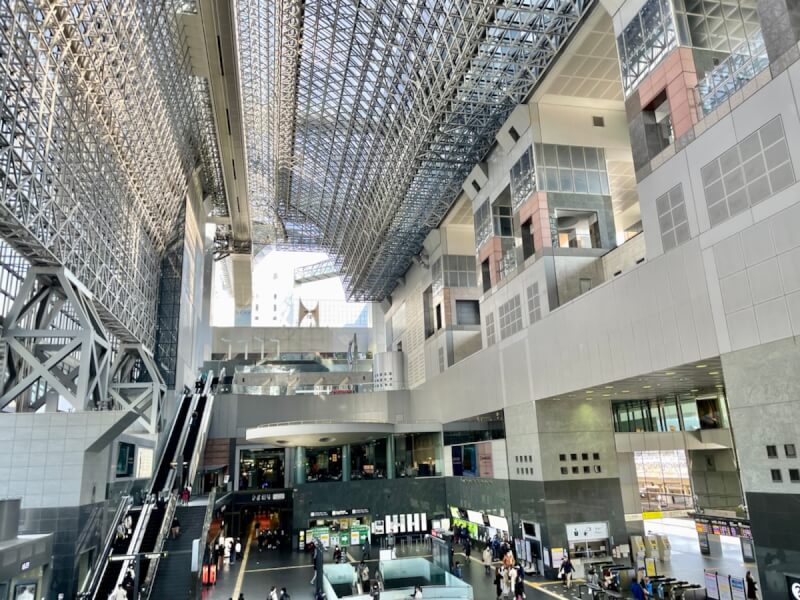
I had some time to kill before my bus ride, so I took a short break at Saryo FUKUCHA Kyoto station Store.
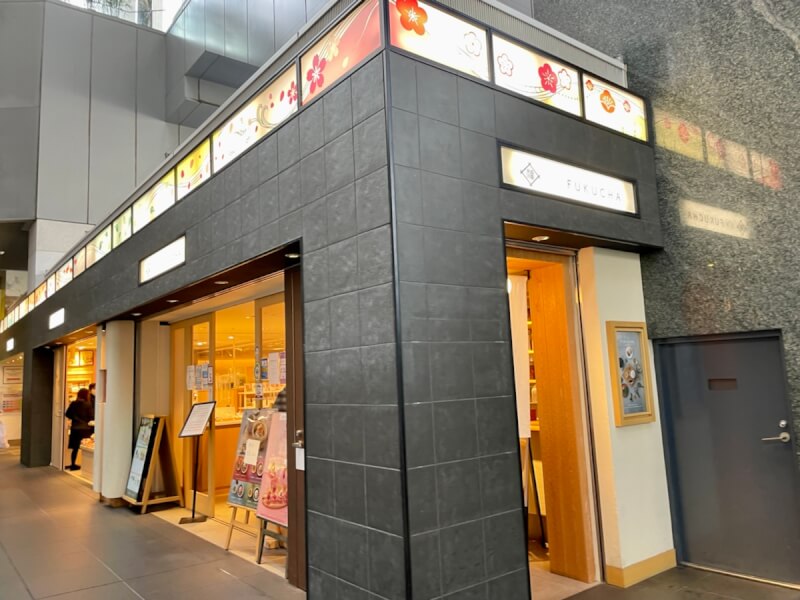
I had Uji tea.
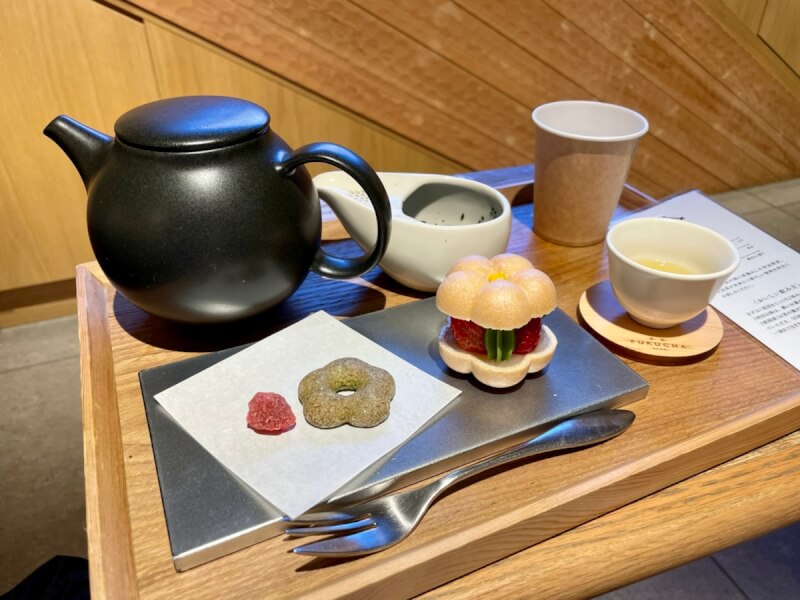
This pastry is called “monaka” and is filled with white bean paste and strawberries.
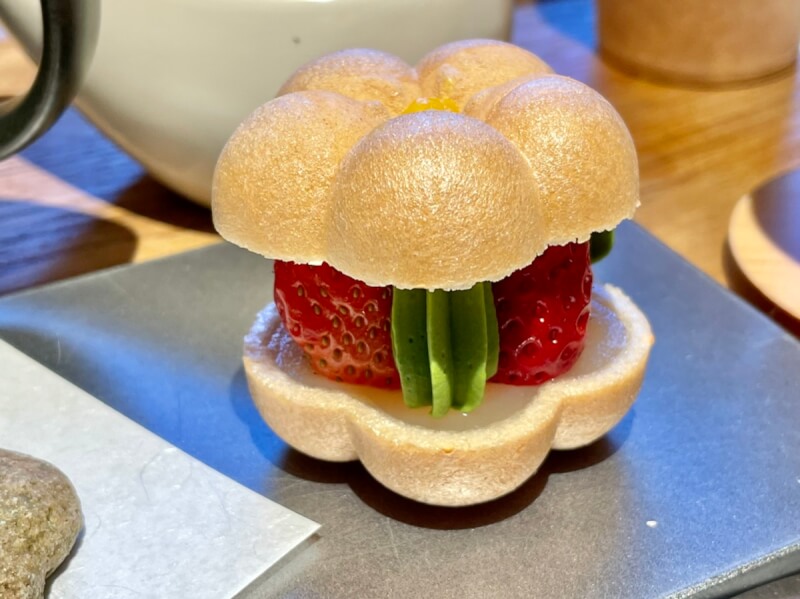
The first time I had Uji tea, it tasted totally different from what I imagined…!
From Kyoto Station, take a bus to Katsura Rikyu
There seem to be several ways to get there, but we took Keihan Kyoto Kotsu Line 26. When we got off at the bus stop “Katsura Rikyu-mae”, we were surprised to find ourselves in a residential area.
We walk along, startled by the sudden appearance of a field managed by the Imperial Household Agency.
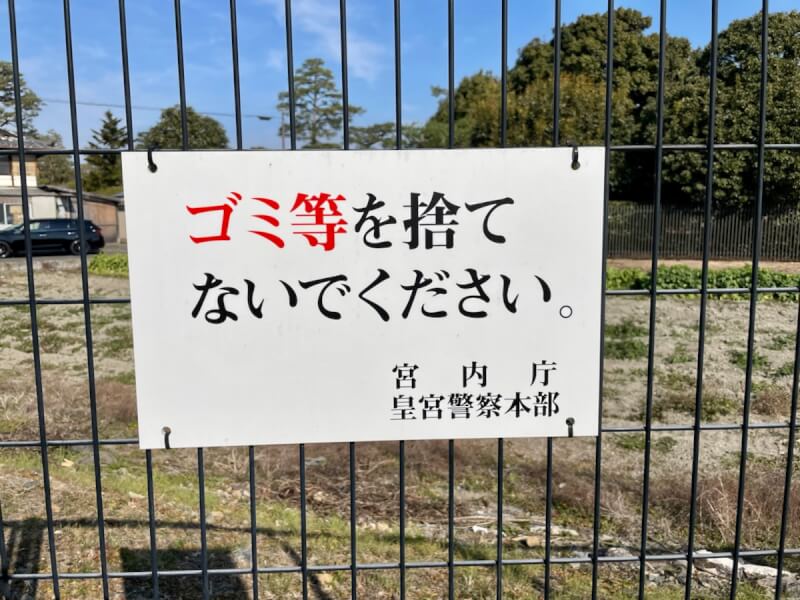
It takes about 15 minutes from the bus stop to reach the entrance of Katsura Rikyu.At the entrance is one of Katsura Rikyu’s famous bamboo fences, the hogaki.
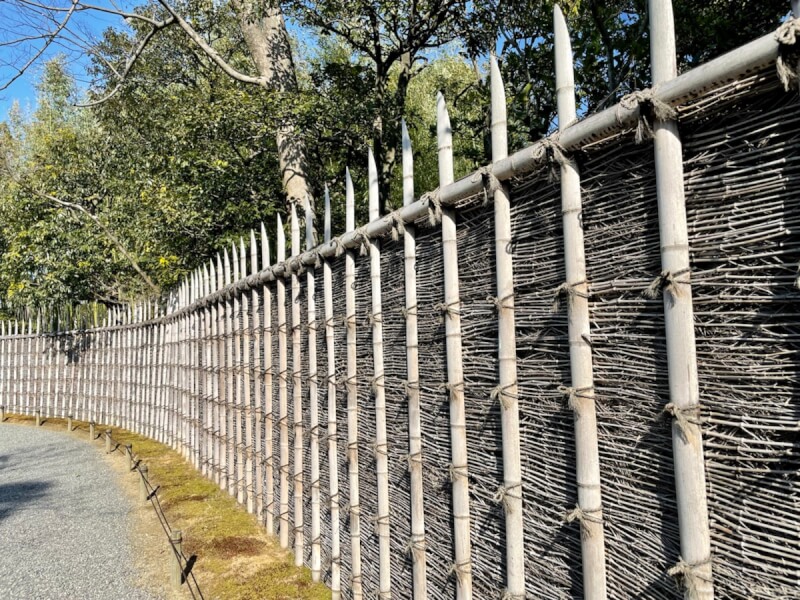
I missed seeing the other famous bamboo fence, the sasagaki…… (crying)
Guided tour of Katsura Rikyu
Hospitality and playfulness in every detail
Katsura Rikyu is a place where the beautiful garden and tea ceremony house, which were created more than 300 years ago, have been maintained and remain.I have no idea what kind of place it is just by looking at it in a book, so my expectations are high.
At the start of the tour, we spent about an hour with a guide going around the gardens of Katsura Rikyu.At first I thought, “I wish I didn’t have to have a guide,” but I soon realized that I definitely had to have a guide!It was a very fulfilling experience that I immediately recognized.
Once inside, you will walk along the Miyuki-michi, a path paved with stones.It is beautiful and very easy to walk.Both sides are slightly lowered for good drainage.
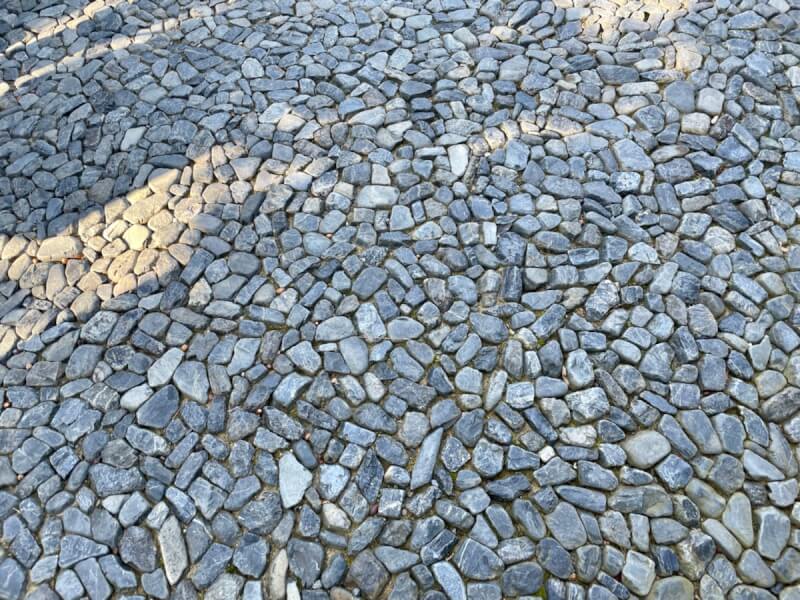
This is Miyuki-mon, the entrance to Katsura Rikyu.The pillars are fashionable in that they dare to use them without peeling the bark.

The road in front of Miyuki-Mon is thicker toward Miyuki-Mon.They say that makes the road look longer.It is amazing that the same thing as Disneyland has existed in Kyoto for 300 years.
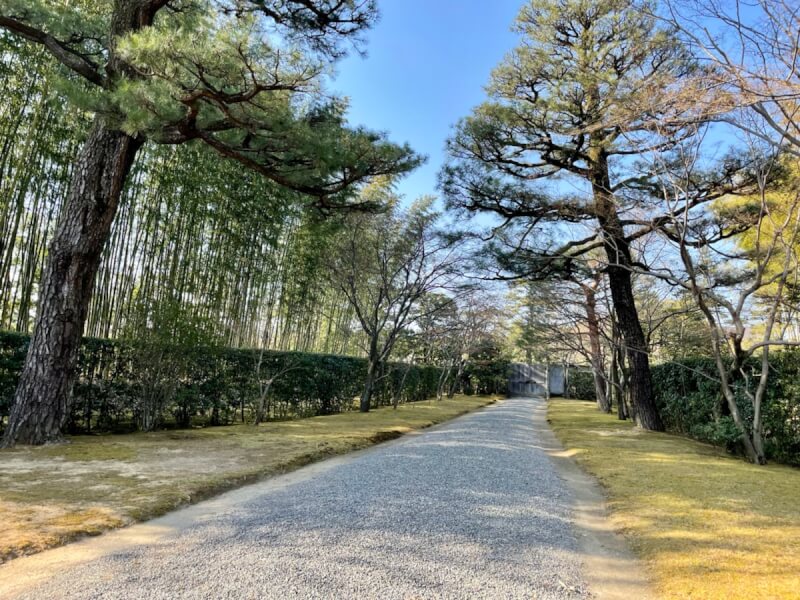
Amazing scenery that changes one after another
The first stop is Okoshikake.It is a small hut, but it is said that people used to dress themselves here to enjoy tea.
Sitting there, you can see trees called sotetsuyama.Sotetsu is a plant called Japanese sago palm in English, and it does not grow in this neighborhood.It was presented by the “Satsuma Shimadu family” in the location where Kagoshima Prefecture is located today.
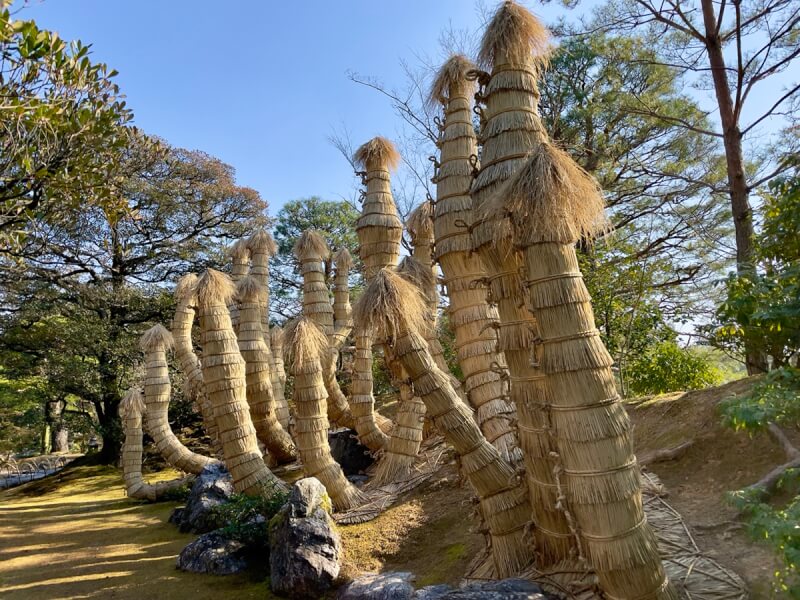
Winters in Kyoto are cold, so Sotetsu, which grows in warmer regions, is wrapped in straw to protect it from the cold.People always like unusual things.
This one is said to be called a Niju Masugata Chozubachi. Niju means double.
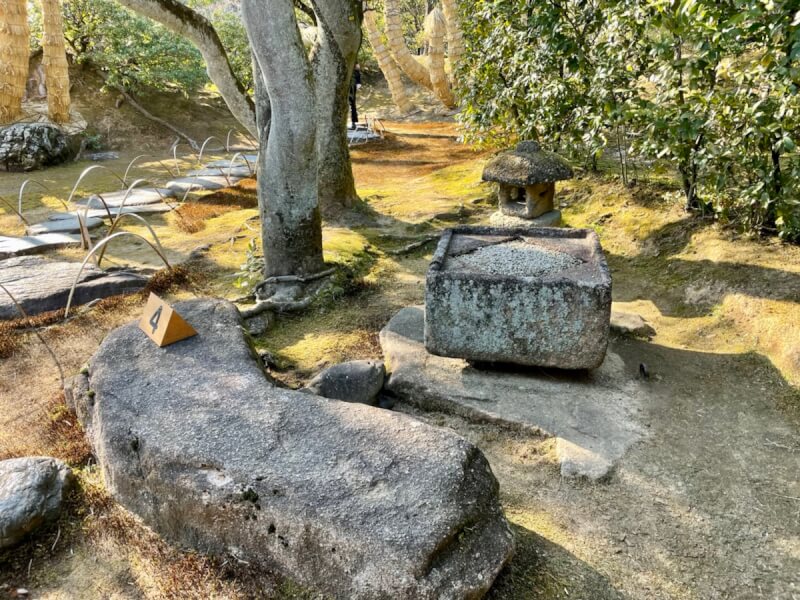
Why double? Because there is another square within a square….Too many stories…!
After a short walk, the next view is of a pond.This view represents the sea, and the bridge in the middle of the picture is said to be inspired by Amanohashidate.The lantern behind the paved stones is said to represent a lighthouse.It is very nice.
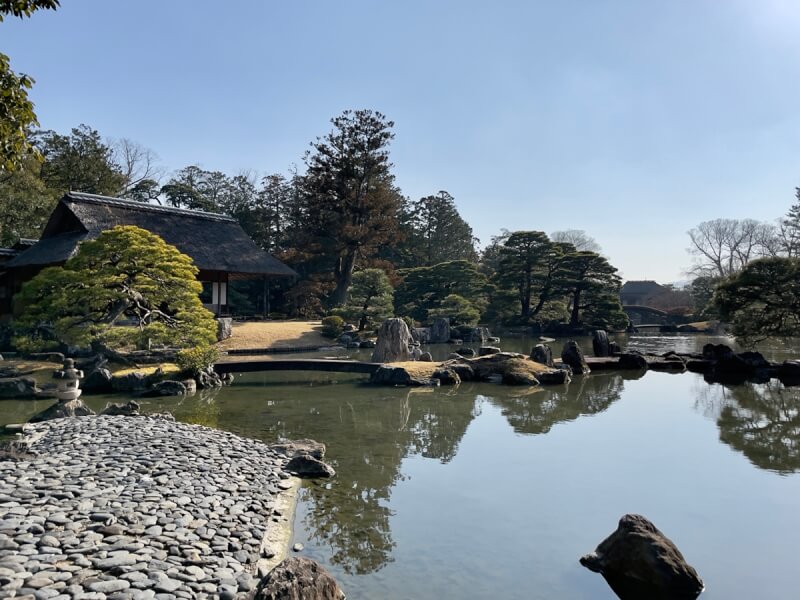
Crossing the stone bridge over the pond, you will arrive at Shokin-tei.The bridge is really narrow, only 65 cm wide, so be careful not to fall off.
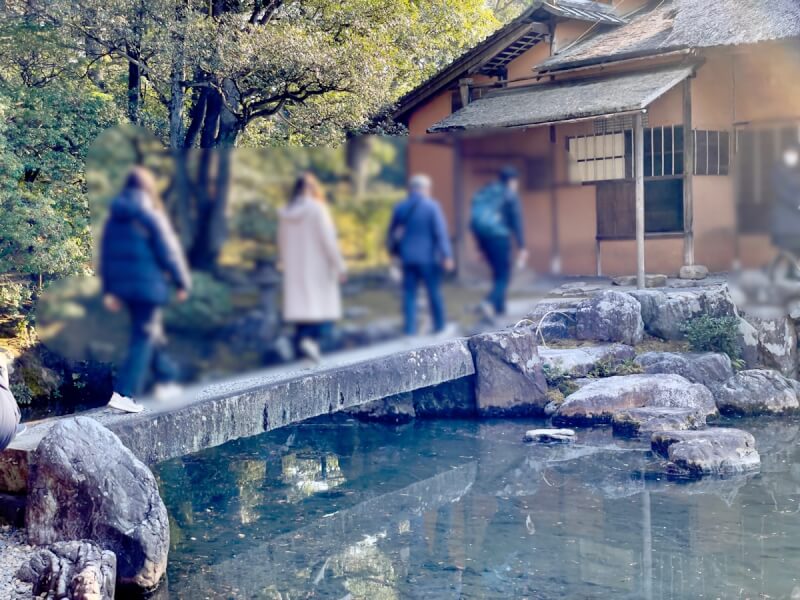
Shokintei is said to be the most prestigious tea house in Katsura Rikyu.And it is said to be the tea room that represents the winter character of Katsura Rikyu.
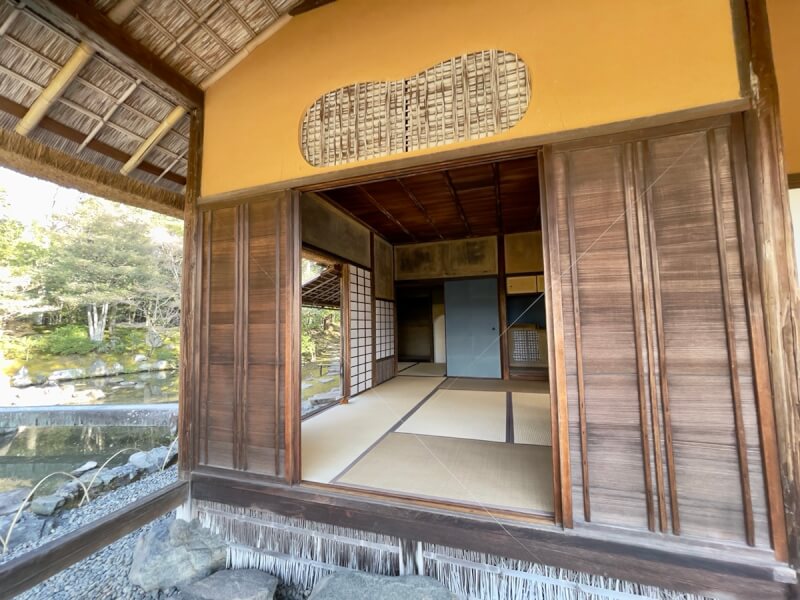
The blue and white checkerboard pattern is very modern.
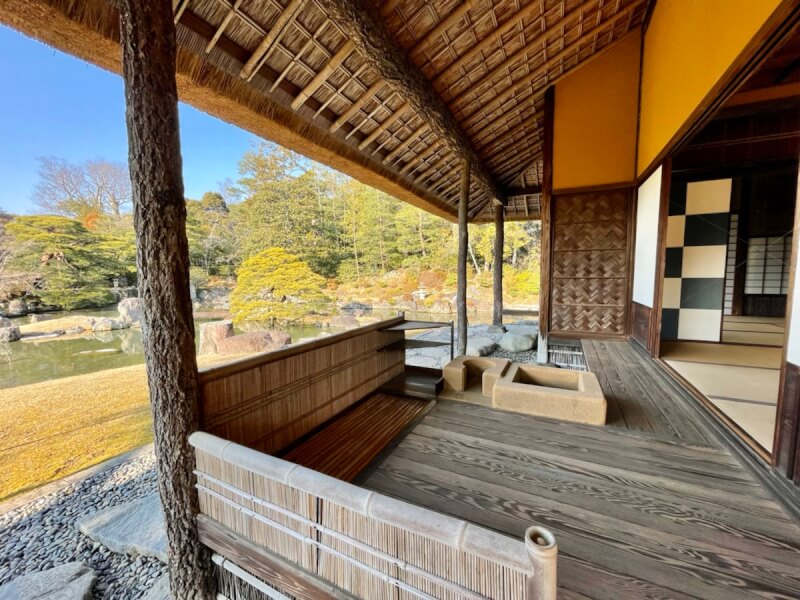
If I were to talk about all of them, the article would never end, so I will skip a few.Next is Onrindo.This is a Buddhist temple, not a tea ceremony room.

The slightly rounded form has a different charm from other tea rooms.The roof is called hogyo-zukuri.
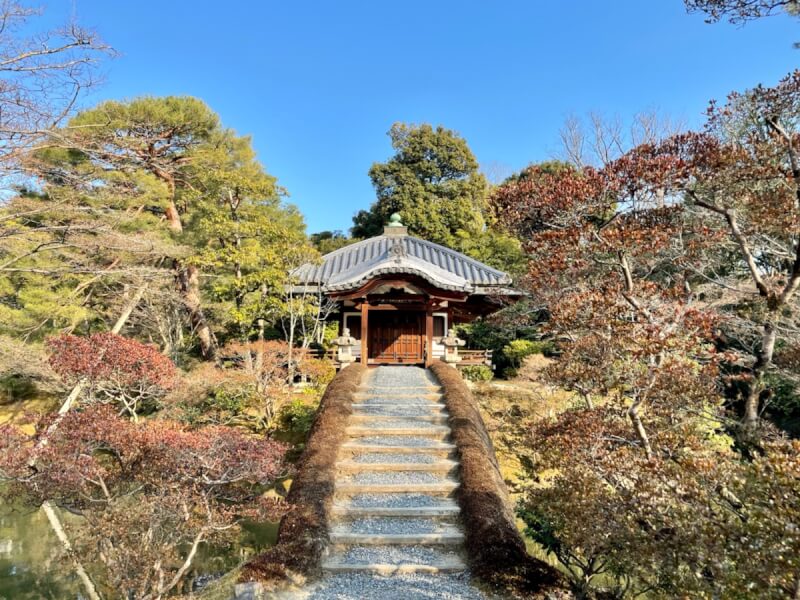
The spirit tablets of the Katsura family were enshrined in the temple.
Next is Shoiken.The large area of land along the pond is a landing place for boats.Inside Katsura Rikyu, each tea house can be accessed by boat.
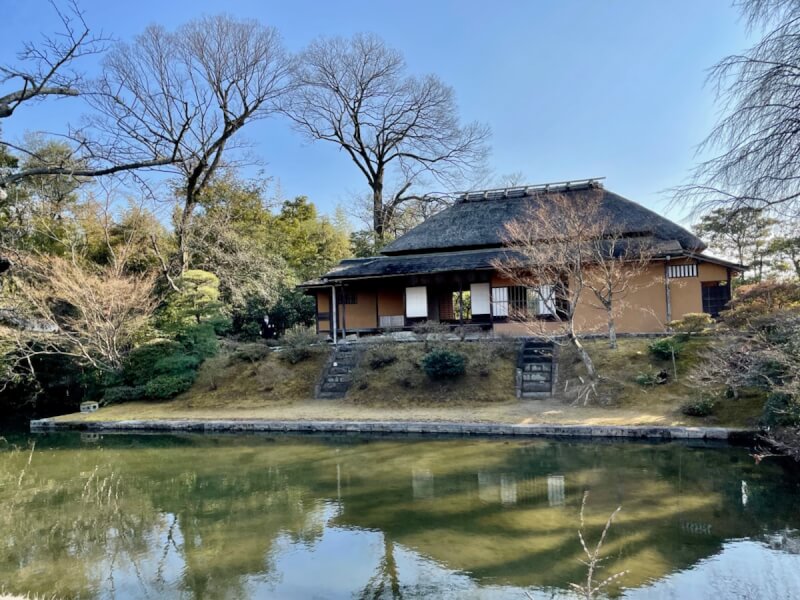
It is a really fun place to walk around a bit and see a different view.
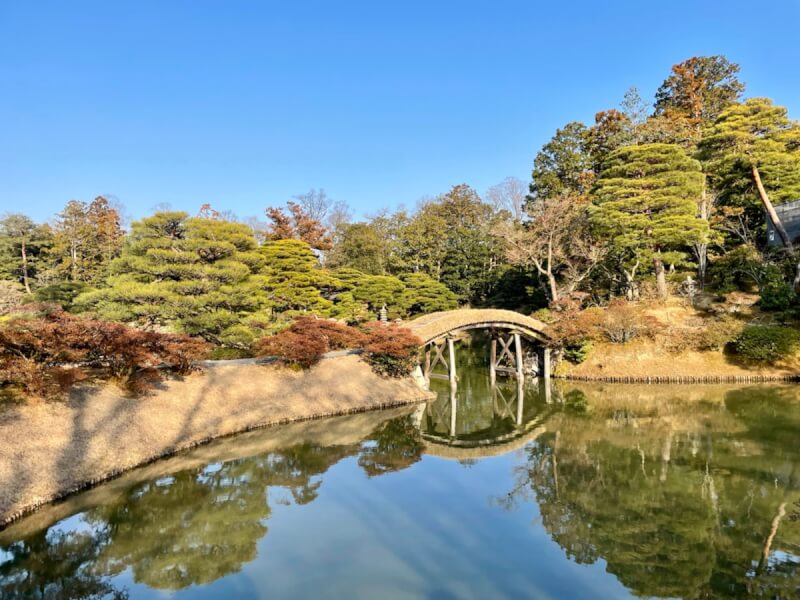
Goten, the center of Katsura Rikyu
Goten is the central building of Katsura-rikyu.
It was constructed in three phases, the oldest being the Koshoin (1624), the Chu-Shoin (1641), and the Shin-Goten (1663), which took 40 years to complete.
Each building is arranged in a zigzag pattern.This arrangement is called a Ganko (flying geese) arrangement, which is analogous to the way geese fly.

Unfortunately, part of the building was under renovation, so we could not see the full view, but it gave us a reason to come back.
The Koshoin has a balcony called Tsukimidai for enjoying moon viewing.It is elegant.
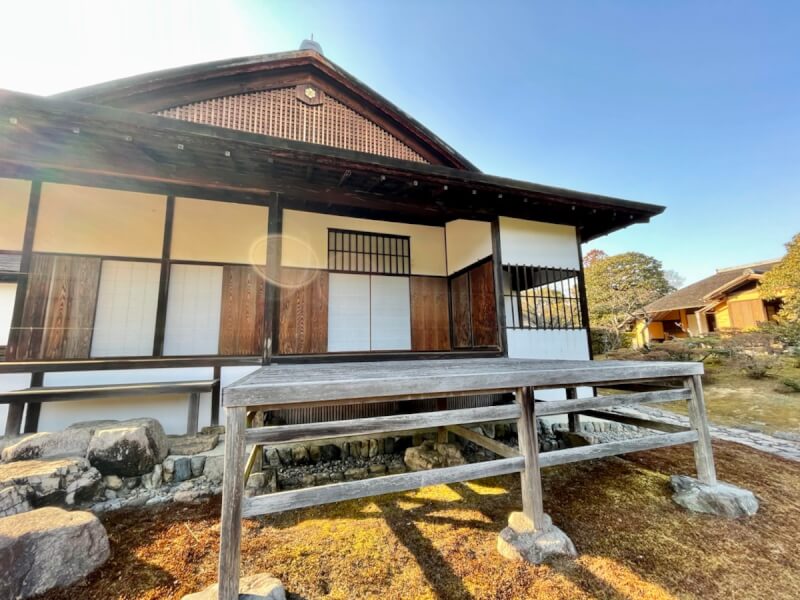
From Tsukimidai, you can see the pond, trees, and the moon at the same time.It is a well-calculated structure designed to provide a clear view of the moon.
Guided tour comes to an end in Gepparo
The teahouse seen at the end of the tour is here, Gepparo.The view on the other side is Shokintei.
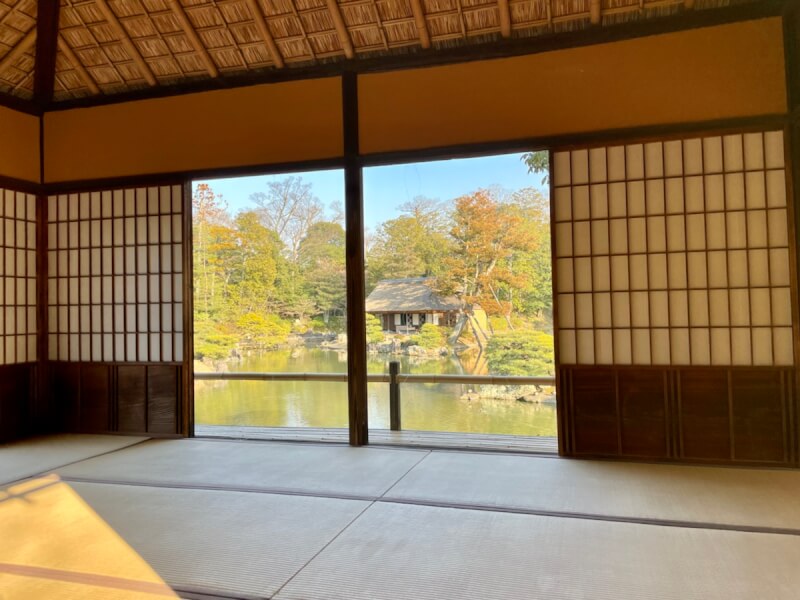
The ceiling is designed to resemble an upturned ship’s bottom.It is called a ship’s bottom ceiling.The ceiling is decorated with pictures of ships.The pillars supporting the ceiling in the center are thin and bent, making them look somewhat thin, but they are said to be decorative and not structural.
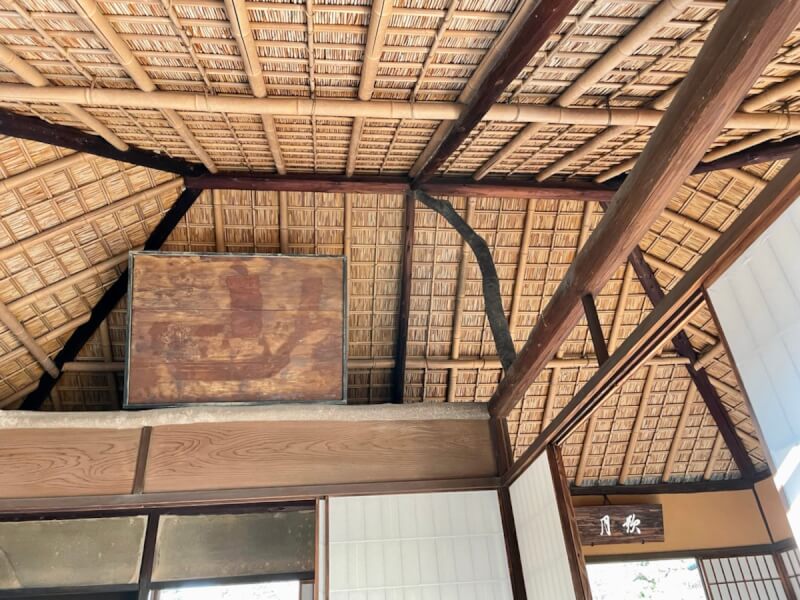
They do that to make it look light and very chic.
I want to come back to enjoy the expressions of the four seasons.
The path is terminated by a pine tree, which is called a tsuitate-matsu, and is said to be responsible for increasing the sense of anticipation by hiding the view of the inside from the outside.
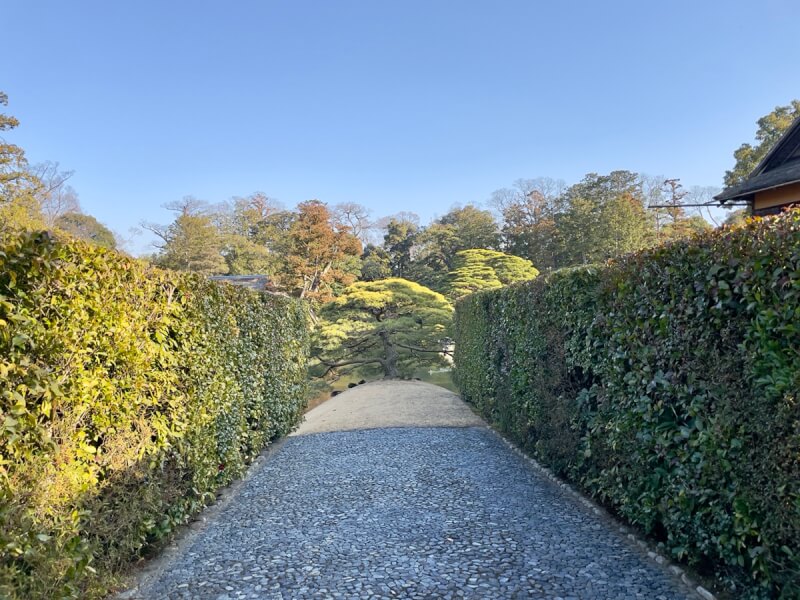
It is graceful to blur it with pine, not to hide it completely.The uncompromising playfulness in every detail was amazing.It was a circular garden with a tremendous amount of information for about an hour.
I heard that the atmosphere changes with the seasons, so I would like to come back in another season.But I wonder if I should make a reservation even for a second time because I want other people to experience it.It was such an experience that I would like to come back again.
After this, we will head to the hotel.To be continued…
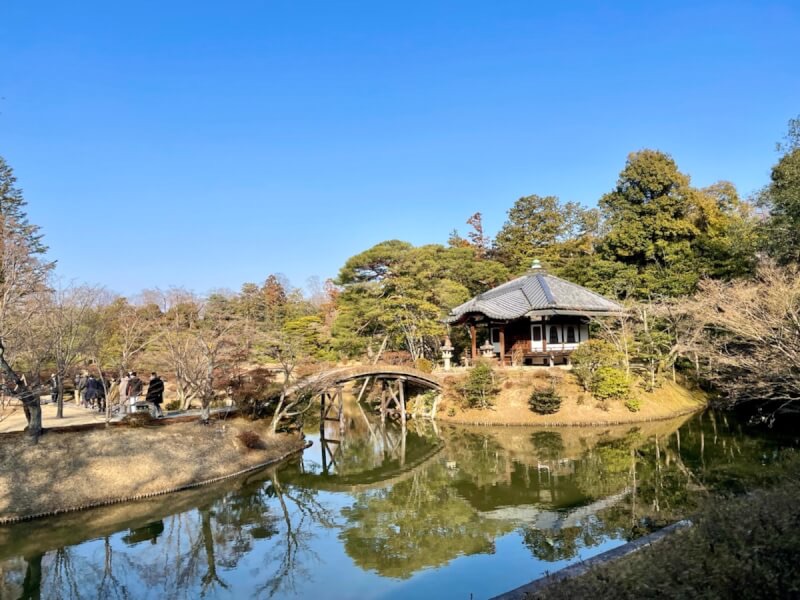

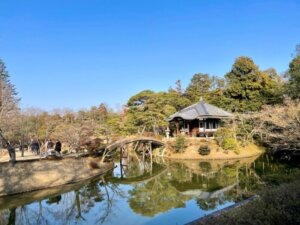
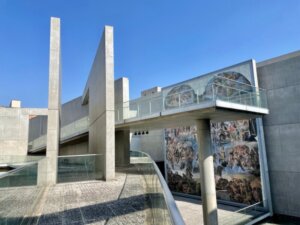
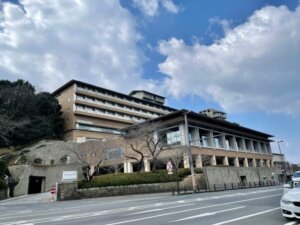
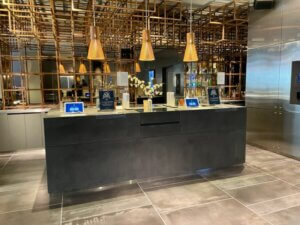
Comments